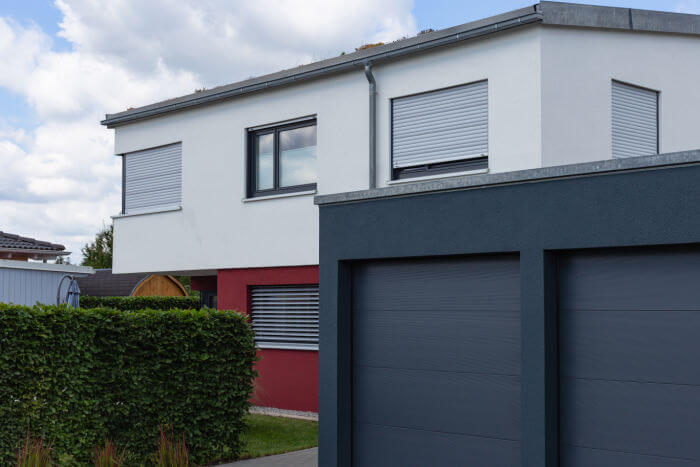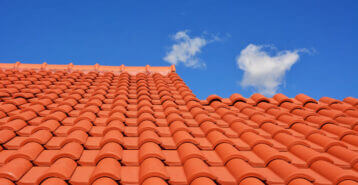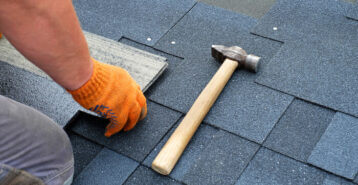Are you doing a roofing project?
Modernize can pair you with three to four pros in your area, so you can compare options and save time and money.
Flat roofs are not just for industrial warehouses, shopping centers and other large commercial properties. They can provide residential homeowners with many important benefits as well. Flat roofs give your home clean, sleek roof lines you just cannot achieve with any type of sloped roofing architecture. You can use the additional square footage a flat roof provides to create a unique rooftop garden, or host family gatherings on an expansive rooftop deck. It’s also a perfect place to install your home’s air conditioning units or add a solar panel array.
Most flat roofs will last about 25 years with proper maintenance. Although they are quite strong, flat roofing is not impervious to the elements and water damage. Modernize created this guide about sealing flat roofs to help homeowners understand the maintenance requirements associated with flat roofing, roof coatings, repair, flat roof sealants, and more. As you read you also can determine if sealing a flat roof is a job you can handle yourself, or if it’s something best left to a professional roofing contractor. If so, we’ve got you covered there, as well.
3 Types of Flat Roof Sealants
It helps to know a little bit about your roof. Here are the three main types of flat roof sealants used in residential construction and some of their primary benefits:
Built-up roof
This is a traditional method for sealing flat roofs. Tar paper or fiberglass membrane is laid down and covered with hot tar and gravel. The roofer repeats the process at least three times. This type of roofing is less-expensive than other methods of sealing flat roofs. But it is also very heavy and the gravel often sluffs off.
Modified bitumen
Another asphalt-based roofing system, modified bitumen roofing uses layers of mineral-reinforced bitumen sheets capped by granule-surfaced or metal-foil laminate sheets. This type of flat roof is thick, puncture resistant and holds up well in a variety of temperatures.
Rubber membrane
A tough single-ply membrane made of recycled rubber is laid over the plywood roofing surface and attached with an adhesive. It is inexpensive, but more prone to punctures than other types of flat roofing materials.

Common Roof Leak Points – and Why it’s Important to Seal Them
Water is the bane of all types of roofing. It doesn’t matter if you have a flat roof, hip-and-valley, gable, shed or low-sloping roof. If there’s a way for water to get in, it is a 100-percent certainty that it will penetrate the roof structure.
The latter roofing styles predominantly have water issues around penetration points – such as chimneys, vents, utility pipes, and any point where a sloped roof surface meets a vertical surface such as a wall.
Your flat roofing contractor likely will have installed a variety of protective equipment to safeguard against water problems. Necessary hardware around penetration points includes flashing, rain collars, wraps and flexible rubber pipe boots.
Find the Right Contractor for Your Roofing Project
Whether you’re ready to begin your project now or need some expert advice, our network of contractors are here to help. With a few simple questions, we’ll find the best local professionals for you
Bear in mind: flat roofs are not truly flat. They usually are designed with an almost imperceptible slope or pitch to ensure they shed water towards drain points.
It is important to ensure your flat roof does not leak. Even a small amount of water penetration can lead to expensive damage to your attic and ceiling, ruined insulation, mold, and a host of other unwanted problems. Water damage can lead to the need to replace your flat roof. Follow the steps outlined below to ensure your flat roof is always properly sealed against water.
How to Properly Seal a Flat Roof
Periodically re-sealing your flat roof is the best way to ensure it maintains water-tight integrity.
You can use roofer’s caulking to seal your flat roof at the penetration points listed above. It is recommended that you remove any layers of dried-up caulking or flat roof sealant prior before applying a new bead of roofer’s caulk. You also can use roofer’s caulk to seal any puncture holes or small ¼- to ½-inch tears in your roofing.

Caulking the Roof
Applying caulking is an easy do-it-yourself job. But it is also a stop-gap measure because caulking comes with a few inherent drawbacks:
- Becomes brittle over time
- May poorly adhere to construction materials
- Doesn’t have much flexibility
- Has limited durability
There are three main types of roof caulking: Acrylic latex, vinyl acetate and butyl. Discuss your roof and leak situation with a home improvement retail specialist to determine which type of caulk best meets your needs. Factors that also can determine your caulking options include climate, moisture and temperature.
Bigger Repair Jobs
For bigger sealing jobs, there are many flat roof sealing products homeowners can apply themselves:
- Roofer’s tape. For slightly larger repair jobs on seams or tears, homeowners can use 6-inch wide roofer’s tape. You’ll prime the surface with a bitumen liquid coating and then roll the tape over the adhesive.
- Peel-and-stick bitumen repair patches. Roofing supply retailers should sell this specialty roof repair product. Apply the patch to a completely clean surface that’s free of gravel and other loose detritus to ensure proper adhesion.
- Fluid elastomeric coatings. These roll-on or spray-on products provide a water-tight seal and can extend the life of your flat roof.
Each of these DIY fixes can be completed by most homeowners. However, it is important to note that if your flat roofing material is exceptionally degraded or the roof has large leaks, you will need to hire a qualified roofing contractor to conduct a much more extensive waterproofing repair job. Use the Modernize roofing cost calculator to estimate the cost of your repair project and find professional roofing contractors in your area.
Find the Right Contractor for Your Roofing Project
Whether you’re ready to begin your project now or need some expert advice, our network of contractors are here to help. With a few simple questions, we’ll find the best local professionals for you
Reviews from Real Homeowners
Welcome to Homeowner Resources! We are the Modernize blog. Modernize pairs more than 3 million homeowners a year with pre-vetted contractors in their area. This blog started because we believe homeowners should know everything about their homes, from how their HVAC works to which front door colors they might love. On Homeowner Resources, you can find information on every part of your home, right down to how you can negotiate with contractors to get the best price. Here's more about the blog.
Need a contractor? Learn more about how Modernize finds the right pro for you.


